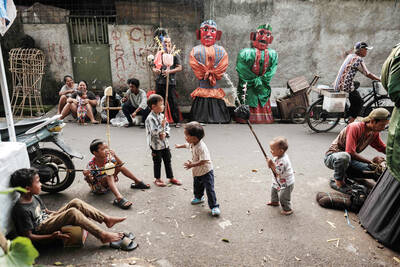With tens of thousands of style moguls in the world’s fashion capital this month checking out and stocking up on the latest trends, counterfeiters and crime-busters are having a field day.
From jewelry to apparel to home accessories and goods, the city’s twice-yearly trend and trade shows held on the eve of Paris Fashion Week attract more than 100,000 buyers and designers, both domestic and foreign.
Photographs are banned and access severely restricted to stands at the half dozen events taking place in town, yet at this week’s lingerie show a top lace-maker from Austria was furious.
On visiting the Mode City trends center, a focal point for makers of underwear and swimwear looking for next season’s colors, fabrics and cuts, Markus Hammerle stumbled onto one of his own exclusive laces — but it was a forgery being exhibited by an Italian firm as its own design.
“All our designs are offered on an exclusive basis to our clients,” he said. “If they see a copy elsewhere they might conclude we were selling them counterfeits, that we were cheats. This could damage our reputation.”
Long blamed on Asia and believed to be restricted to luxury brands, counterfeiting clothes is widespread across Europe and as often as not practiced by reputable high street brands, said specialist lawyer Corinne Champagner Katz.
As head of a prestigious one-hundred-year-old embroidery firm on Lake Constance that sells to established lingerie brands such as Triumph or Wacoal, Hammerle took his case to her and within 24 hours had secured a signed pledge from the Italian counterfeiter to withdraw the lace from sale.
“We invest a lot of money in design and research,” Hammerle said in an interview.
“This is a huge problem. When designers are faced by counterfeiters they must take action as we did. You musn’t let forgers feel they can get away with it,” he said.
Though they may seem insignificant, the swatches of lace trimming on underwear, not to mention wedding gowns, are key to sales.
“It’s that piece of lace that will sell a bra,” said Champagner Katz, who for several years has been helping lingerie makers protect their rights during the Paris shows.
“Lace is a prime victim of forgery,” she added.
Industrial espionage and forgery were age-old problems, she said, “but there are more and more copies being made in every sector of the fashion field. And with the modernization of communication the copies are quick.”
At the exclusive fabrics fair, Premiere Vision, where stands have high enough walls to conceal the samples, one resourceful counterfeiter used a watch-camera that transmitted snapshots directly via the Internet.
“Whenever you come up with a really exceptional design you can be sure someone else will copy it,” said Christian Keusseyan, joint director of French swimsuit and lingerie firm Pain de Sucre.
“If it’s a tiny boutique or a small company we don’t react because fashion after all is always inspired by someone else’s design. But when it’s a well-known brand with a turnover 10 times as big as ours that exports across the world, it’s unacceptable. It’s like being robbed,” Keusseyan said from inside his stand, where staff admit visitors only after checking their credentials.
Keusseyan’s company produces 200,000 swimsuits a year and has already won lawsuits for copyright breach against Spain’s Manuel Canovas, Italy’s Argento Vivo and known brands from France, Germany and Australia.
A complaint has also been filed against one of the top US labels, which cannot be named with the case still pending.
“It can take us three to four years to get a design just right and then that model will sell through several seasons in different fabrics,” Keusseyan said.
“No one would copy the Coca-Cola or Evian bottle, would they?” he said.

In the sweltering streets of Jakarta, buskers carry towering, hollow puppets and pass around a bucket for donations. Now, they fear becoming outlaws. City authorities said they would crack down on use of the sacred ondel-ondel puppets, which can stand as tall as a truck, and they are drafting legislation to remove what they view as a street nuisance. Performances featuring the puppets — originally used by Jakarta’s Betawi people to ward off evil spirits — would be allowed only at set events. The ban could leave many ondel-ondel buskers in Jakarta jobless. “I am confused and anxious. I fear getting raided or even

Kemal Ozdemir looked up at the bare peaks of Mount Cilo in Turkey’s Kurdish majority southeast. “There were glaciers 10 years ago,” he recalled under a cloudless sky. A mountain guide for 15 years, Ozdemir then turned toward the torrent carrying dozens of blocks of ice below a slope covered with grass and rocks — a sign of glacier loss being exacerbated by global warming. “You can see that there are quite a few pieces of glacier in the water right now ... the reason why the waterfalls flow lushly actually shows us how fast the ice is melting,” he said.

Eleven people, including a former minister, were arrested in Serbia on Friday over a train station disaster in which 16 people died. The concrete canopy of the newly renovated station in the northern city of Novi Sad collapsed on Nov. 1, 2024 in a disaster widely blamed on corruption and poor oversight. It sparked a wave of student-led protests and led to the resignation of then-Serbian prime minister Milos Vucevic and the fall of his government. The public prosecutor’s office in Novi Sad opened an investigation into the accident and deaths. In February, the public prosecutor’s office for organized crime opened another probe into

RISING RACISM: A Japanese group called on China to assure safety in the country, while the Chinese embassy in Tokyo urged action against a ‘surge in xenophobia’ A Japanese woman living in China was attacked and injured by a man in a subway station in Suzhou, China, Japanese media said, hours after two Chinese men were seriously injured in violence in Tokyo. The attacks on Thursday raised concern about xenophobic sentiment in China and Japan that have been blamed for assaults in both countries. It was the third attack involving Japanese living in China since last year. In the two previous cases in China, Chinese authorities have insisted they were isolated incidents. Japanese broadcaster NHK did not identify the woman injured in Suzhou by name, but, citing the Japanese